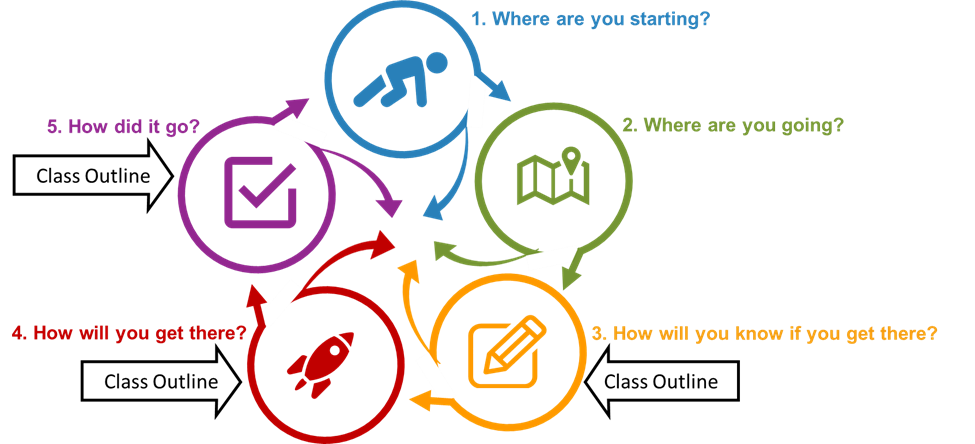
B. Learning & Instructional Design Principles
B5. Principles for Class Outlines
Principles for Class Outlines
When teaching content, we often think about the structure of the content, sequencing the material from large to small, small to large, local to general, general to local, etc. This is often providing the answers to the WHAT and HOW of the content.
- WHAT:
- “What is the definition of … ?”
- “What do we know about… “”
- “What can we create from… ?”
- “What did xxx mean… ?”
- HOW:
- “How do I use this… ?”
- “How does this work… ?”
- “How do we apply this… ?”
Two additional questions should be included: WHY and WHAT IF?
- WHY:
- “Why is this important to you?”
- “Why should you learn this?”
- “Why do experts believe this?”
- “Why do we need to do this?”
- WHAT IF:
- “What if we change this…”
- “What if xxx happens?”
- “What if xxx condition changes?”
These four questions should be included in every class outline. Typically, these would be sequenced as WHY, WHAT, HOW, and then WHAT IF (These four questions are detailed in the 4MAT design by McCarthy, 2000).
In addition, the following principles, often referred to Gagné’s Nine Events of Instruction, are, basically, events that should be included when presenting new material (such as a new unit) (Gagné et al., 2005). The following is based on Northern Illinois University Center for Innovative Teaching and Learning’s website (2020):
- Gain attention – provide students with a reason for wanting to learn the material in this unit. Some common methods:
- Stimulate students with novelty, uncertainty, and surprise
- Pose thought-provoking questions to students
- Have students pose questions to be answered by other students
- Inform learners of the objectives – tell the students why they should learn this and how it ties in with the course outcomes. Some common methods:
- Describe what they have to do, including how well (provide a rubric); alternately, consider having them set their own standard of performance
- Include course objectives on assessments
- Stimulate recall of prior learning – relate the new material to what they already know, using previous lessons and/or previous knowledge. Some common methods:
- Discuss previously covered concepts
- Ask questions about previous concepts that will lead the students to make connections
- Present the content – provide new material. Some common methods:
- Present vocabulary and concepts
- Use a variety of media and activities
- Provide examples
- Provide learning guidance – provide scaffolding/context for new material (refer to ZPD, Chapter A8). Some common methods:
- Use scaffolding and slowly remove it
- Provide series of hints or questions
- Elicit performance/practice – Provide activities that demonstrate ability to meet the objective (see Chapter C7). Some common methods:
- Provide formative or summative tests or quizzes
- Assign a written assignment or project (group or individual)
- Ask probing questions
- Provide feedback – Some common methods:
- Provide individual feedback (see Chapter C10)
- Assign peer feedback
- Assess performance – measure student and lesson effectiveness. Some common methods:
- Provide formative or summative tests or quizzes
- Compare student performance against a rubric and/or the less objectives
- Enhance retention and transfer – provide follow-up practice and review. Some common methods:
- Summarize the unit by reviewing the objectives and how they connect to the course outcomes
- Use a review of the information at the beginning of future units
- Incorporate the information into future units
- Use the information as scaffolding for future units
- Ask students to develop concept maps which they can use for review
IDI & Class Outlines

The following describe actions you can take to use concepts from class outlines in the IDI model:
Step 3. How Will You Know If You Get There?
3.1 Develop Assessments & Rubrics
- Identify what students have to do, including how well (provide a rubric)
- Consider allowing students to define their own individual standard of performance
Step 4. How Will You Get There?
4.1 Develop & Teach Course
- Identify activities that teach them what they have to do to accomplish the learning outcomes and include how well (provide a rubric).
- Use Gagné’s Nine Events of Instruction to develop a class outline.
- Provide feedback during discussions.
4.2 Assess Students
- Assess performance
- Provide feedback on all assessments
Step 5. How Did It Go?
5.1 Evaluate Course Success
- Use the class outline to note what went well, what could have been improved, and what you need to change for the next class session.
References
Gagné, R. M., Wager, W. W., Golas, K., & Keller, J. M. (2005). Principles of Instructional Design (5th ed). Thomson/Wadsworth.
McCarthy, B. (2000). 4Mat About Teaching; Format in the Classroom. About Learning Inc.
Northern Illinois University Center for Innovative Teaching and Learning. (2020). Gagne’s Nine Events of Instruction. Instructional Guide for University Faculty and Teaching Assistants. https://www.niu.edu/citl/resources/guides/instructional-guide/gagnes-nine-events-of-instruction.shtml.
Updated 2023-10-2
